Mangroves at Their Limits: Detection and Area Estimation of Mangroves along the Sahara Desert Coast
Abstract
:1. Introduction
2. Materials and Methods
2.1. Study Area
2.2. VHR Data and Field Data
2.3. Accuracy Assessment Procedure
2.3.1. Ground Truth Data
- We divided the ground truth set in half (twofold) to maximize the number of pixels used for training and validation.
- We made only five iterations for two reasons: First, there were small differences between each of the ten error matrices among iterations which always reflected the same type of error. Second, the cross-validation was implemented manually using the Macro Modeler of IDRISI, therefore it was a very time consuming task.
- The training and validation data set for mangroves and other terrestrial vegetation were selected in the West side of the study area because of the availability of field-work information. The bias that can be introduced by this restriction is addressed using the cross-validation technique.
- Finally, we chose the same amount of pixels per class because the area covered by mangroves in the whole image is about 1%. If we used a stratified random sampling to select the training data, we would have ended up with a very low amount of ground truth data to describe the spectral signature of mangroves as compared to the others types of land cover. The non-mangrove classes were not our main focus of classification and their over-representation might have led to poor classification results for the mangrove category. Olofsson et al. (2013) recommended a procedure to eliminate the bias created by classification errors when calculating the area of a category in a land cover map and report confidence intervals [28]. However, this procedure is only applicable when simple random, systematic or stratified random sampling is used. For this reason, given the characteristics of our area of interest and acknowledging that a bias could have been introduced in the calculation of the area, we used as an alternative the cross-validation technique.
2.3.2. Accuracy Metrics
- A box-plot showing the overall accuracy of the ten error matrices. This accuracy takes into account seven classes of interest (i.e., mangrove, other terrestrial vegetation, sea, shallow water, dry soil, wet soil).
- A box-plot showing the specific accuracy of the ten error matrices. The specific accuracy only considers three classes of interest: mangrove, other terrestrial vegetation, and other types of land cover. As mentioned before, the area covered by mangroves is very small compared to other types of land cover like soil and shallow water. The specific accuracy is calculated because the overall accuracy can underestimate errors made in the classification of mangroves. Therefore, it is necessary to have a metric that can provide more information about the classification of mangroves and how well the discrimination with other types of vegetation is done. For the classification, seven classes of interest were initially included in order to have more information about the spectral signatures of the different types of land cover.
- A table showing the commission and omission errors of the ten error matrices.
- A box-plot showing the quantity, exchange, and shift differences of the ten error matrices. These metrics are reported using three classes: mangrove, other terrestrial vegetation, and other types of land cover. Instead of the Kappa Index, Pontius and Millones (2011) and Pontius and Santacruz (2014) propose the use of the quantity, exchange, and shift differences [29,30]. Different authors have suggested that the Kappa Index is not the best option to use as an accuracy assessment metric [27,29]. Quantity refers to the difference, between two land cover maps, in the amount of pixels per category (i.e., class). Exchange refers to the difference in allocation when pixels are interchanged between two categories. Shift refers to other allocation differences that are not included in the exchange difference [29,30]. These metrics are defined based on the error matrix and can be easily calculated with a Microsoft Excel file provided by the authors [30].
3. Results
4. Discussion
5. Conclusions
Acknowledgments
Author Contributions
Conflicts of Interest
Abbreviations
| ML | Maximum Likelihood algorithm |
| NN | Neural Network algorithm |
| PAN | Panchromatic band |
| PCA | Principal Component Analysis |
| PNBA | Parc National du Banc d’Arguin |
| PND | Parc National du Diawling |
| UTM | Universal Transverse Mercator |
| VHR | Very High Resolution |
| XS | Multispectral band |
References
- Gaston, K.J. Geographic range limits of species. Proc. R. Soc. 2009, 276, 1391–1393. [Google Scholar] [CrossRef] [PubMed]
- Sexton, J.; McIntyre, P.J.; Angert, A.L.; Rice, K.J. Evolution and ecology of species range limits. Annu. Rev. Ecol. Evol. Syst. 2009, 40, 415–436. [Google Scholar] [CrossRef]
- Thuiller, W. BIOMOD—Optimizing predictions of species distributions and projecting potential future shifts under global change. Glob. Chang. Biol. 2003, 9, 1353–1362. [Google Scholar] [CrossRef]
- Mukherjee, N.; Sutherland, W.J.; Khan, M.N.I.; Berger, U.; Schmitz, N.; Dahdhouh-Guebas, F.; Koedam, N. Using expert knowledge and modeling to define mangrove composition, functioning, and threats and estimate time frame of recovery. Ecol. Evol. 2014, 4, 2247–2262. [Google Scholar] [CrossRef] [PubMed]
- Duke, N.C.; Ball, M.C.; Ellison, J.C. Factors influencing biodiversity and distributional gradients in mangroves. Glob. Ecol. Biogeogr. Lett. 1998, 7, 27–47. [Google Scholar] [CrossRef]
- Ellison, A. Macroecology of mangroves: Large-scale patterns and processes in tropical coastal forests. Trees 2002, 16, 181–194. [Google Scholar] [CrossRef]
- Spalding, M.; Kainuma, M.; Collins, L. World Atlas of Mangroves; Earthscan: London, UK, 2010. [Google Scholar]
- Dahdouh-Guebas, F.; Koedam, N. Are the northernmost mangroves of West-Africa viable?—A case study in Banc d’Arguin National Park, Mauritania. Hydrobiologia 2001, 458, 241–253. [Google Scholar] [CrossRef]
- Saintlan, N.; Rogers, K.; McKee, K. Salt marsh-mangrove interactions in Australasia and the Americas. In Coastal Wetlands: An Integrated Ecosystem Approach; Elsevier: Amsterdam, The Netherlands, 2009. [Google Scholar]
- Duke, N.C. Australia’s Mangroves. In The Authoritative Guide to Australia’s Mangrove Plants; University of Queensland: Brisbane, Australia, 2006. [Google Scholar]
- Quisthoudt, K.; Schmitz, N.; Randin, C.F.; Dahdouh-Guebas, F.; Robert, E.M.R.; Koedam, N. Temperature variation among mangrove latitudinal range limits worldwide. Trees 2012, 26, 1919–1931. [Google Scholar] [CrossRef]
- Blasco, F. About the mangroves of Banc d’Arguin, Mauritania. ISME/GLOMIS Electron. J. 2010, 8, 13–15. [Google Scholar]
- Giri, C.; Ochieng, E.; Tieszen, L.L.; Zhu, Z.; Singh, A.; Loveland, T.; Masek, J.; Duke, N. Status and distribution of mangrove forest of the world using earth observation satellite data. Glob. Ecol. Biogeogr. 2011, 20, 154–159. [Google Scholar] [CrossRef]
- Lamarche, S. Cartographie et Répartition de la Végétation du Cap Timiris; Observatoire du Parc National du Banc d’Arguin: Nouadhibou, Mauritania, 2008. [Google Scholar]
- United Nations Environment Programme (UNEP). Mangroves of Western and Central Africa; UNEP Regional Seas Programme/UNEP—World Conservation Monitoring Centre (WCMC): Cambridge, UK, 2007. [Google Scholar]
- Fatoyinbo, T.E.; Simard, M. Height and biomass of mangroves in Africa from ICESat/GLAS and SRTM. Int. J. Remote Sens. 2013, 34, 668–681. [Google Scholar] [CrossRef]
- Turner, W.; Spector, S.; Gardiner, N.; Fladeland, M.; Sterling, E.; Steininger, M. Remote sensing for biodiversity science and conservation. Trends Ecol. Conserv. 2003, 18, 306–314. [Google Scholar] [CrossRef]
- Kerr, J.T.; Ostrovsky, M. From space to species: Ecological applications for remote sensing. Trends Ecol. Conserv. 2003, 18, 299–305. [Google Scholar] [CrossRef]
- United Nations Educational, Scientific and Cultural Organization (UNESCO), World Heritage Convention. State of Conservation: Banc d’Arguin National Park 2013. Available online: http://whc.unesco.org/en/soc/1924 (accessed on 5 March 2016).
- Ramsar Convention on Wetlands. Ramsar Sites Information Service. Available online: https://rsis.ramsar.org/ris/250 (accessed on 5 March 2016).
- Van der Laan, B.P.A.; Wolff, W.J. Circular pools in the seagrass beds of the Banc d’Arguin, Mauritania, and their possible origin. Aquat. Bot. 2006, 84, 93–100. [Google Scholar] [CrossRef]
- Hagemeijer, W.; Smit, C.; de Boer, P.; Van Dijk, A.; Ravenscroft, N.; Van Roomen, M.; Wright, M. Wader and Waterbird Census at the Banc d’Arguin, Mauritania, January 2000; IWO Report 81; Foundation Working Group International Waterbird and Wetland Research (WIWO): Nijmegen, The Netherlands, 2004; pp. 3–141. [Google Scholar]
- Leyrer, J.; Spaans, B.; Camara, M.; Piersma, T. Small home ranges and high site fidelity in red knots (Calidris c. canutus) wintering on the Banc d’Arguin, Mauritania. J. Ornithol. 2006, 147, 376–384. [Google Scholar] [CrossRef]
- Dia, A.T.; Colas, F.; De Wispelaere, G. Contribution à L’étude des Milieux Naturels du Littoral Mauritanien. In Proceedings of the Environnement at Littoral Mauritanien: Actes du Colloque, Nouakchott, Mauritanie, Montpellier, France, 12–13 June 1995.
- DigitalGlobe. Standard Imagery Datasheet. Available online: http://global.digitalglobe.com/sites/default/files/StandardImagery-DS-STAND_1-22-14_0.pdf (accessed on 3 March 2016).
- Foody, G.M. Status of land cover classification accuracy assessment. Remote Sens. Environ. 2002, 80, 185–201. [Google Scholar] [CrossRef]
- Olofsson, P.; Foody, G.M.; Herold, M.; Stehman, S.V.; Woodcock, C.E.; Wulder, M.A. Good practices for estimating area and assessing accuracy of land change. Remote Sens. Environ. 2014, 148, 42–57. [Google Scholar] [CrossRef]
- Olofsson, P.; Foody, G.M.; Stehman, S.; Woodcock, C.E. Making better use of accuracy data in land change studies: Estimating accuracy and area and quantifying uncertainty using stratified estimation. Remote Sens. Environ. 2013, 129, 122–131. [Google Scholar] [CrossRef]
- Pontius, R.G.; Millones, M. Death to Kappa: Birth of quantity disagreement and allocation disagreement for accuracy assessment. Int. J. Remote Sens. 2011, 32, 4407–4429. [Google Scholar] [CrossRef]
- Pontius, R.G.; Santacruz, A. Quantity, exchange, and shift components of difference in a square contingency table. Int. J. Remote Sens. 2014, 35, 7543–7554. [Google Scholar] [CrossRef]
- Stehman, S.V. Sampling designs for accuracy assessment of land cover. Int. J. Remote Sens. 2009, 30, 5243–5272. [Google Scholar] [CrossRef]
- Kohavi, R. A study of cross-validation and bootstrap for accuracy estimation and model selection. In Proceedings of the International Joint Conference on Artificial Intelligence (IJCAI), Montreal, QC, Canada, 20–25 August 1995.
- Gao, Y. A comparative study on spatial and spectral resolution of satellite data in mapping mangrove forests. Int. J. Remote Sens. 1999, 20, 2823–2833. [Google Scholar] [CrossRef]
- Kuenzer, C.; Bluemel, A.; Gebhardt, S.; Quoc, T.V.; Dech, S. Remote sensing of mangrove ecosystems: A review. Remote Sens. 2011, 3, 878–928. [Google Scholar] [CrossRef]
- Satyanarayana, B.; Mohamad, K.A.; Idris, I.F.; Husain, M.; Dahdouh-Guebas, F. Assessment of mangrove vegetation based on remote sensing and ground-truth measurements at Tumpat, Kelantan Delta, East Coast of Peninsular Malaysia. Int. J. Remote Sens. 2011, 32, 1635–1650. [Google Scholar] [CrossRef]
- Saito, H.; Bellan, M.F.; Al-Habshi, A.; Aizpuru, M.; Blasco, F. Mangrove research and coastal ecosystem studies with SPOT-4 HR VIR and TERRA ASTER in Arabian Gulf. Int. J. Remote Sens. 2003, 24, 4073–4092. [Google Scholar] [CrossRef]
- Wang, L.; Sousa, W.P.; Gong, P. Integration of object-based and pixel-based classification for mapping mangroves with IKONOS imagery. Int. J. Remote Sens. 2004, 25, 5655–5668. [Google Scholar] [CrossRef]
- Foody, G.M.; Arora, M.K. An evaluation of some factors affecting the accuracy of classification by an artificial neural network. Int. J. Remote Sens. 1997, 18, 799–810. [Google Scholar] [CrossRef]
- Wang, L.; Silván-Cárdenas, J.L.; Sousa, W.P. Neural Network Classification of Mangrove Species from Multi-Seasonal Ikonos Imagery. Photogramm. Eng. Remote Sens. 2008, 74, 921–927. [Google Scholar] [CrossRef]
- Al Habshi, A.; Youssef, T.; Aizpuru, M.; Blasco, F. New mangrove ecosystem data along the UAE coast using remote sensing. Aquat. Ecosyst. Health Manag. 2007, 10, 309–319. [Google Scholar] [CrossRef]
- Brovelli, M.A.; Crespi, M.; Fratarcangeli, F.; Giannone, F.; Realini, E. Accuracy assessment of high resolution satellite imagery orientation by leave-one-out method. ISPRS J. Photogramm. Remote Sens. 2008, 63, 427–440. [Google Scholar] [CrossRef]
- Franco-Lopez, H.; Ek, A.R.; Bauer, M.E. Estimation and mapping of forest stand density, volume and cover type using the k-nearest neighbors method. Remote Sens. Environ. 2001, 77, 251–274. [Google Scholar] [CrossRef]
- Benediktsson, J.A.; Chanussot, J.; Fauvel, M. Multiple Classifier Systems in Remote Sensing: From Basics to Recent Developments. In Proceedings of the Multiple Classifier Systems, 7th International Workshop, MCS 2007, Prague, Czech Republic, 23–25 May 2007.
- Whiteside, T.G.; Bartolo, R.E. Mapping aquatic vegetation in a tropical wetland using high spatial resolution multispectral satellite imagery. Remote Sens. 2015, 7, 11664–11694. [Google Scholar] [CrossRef]
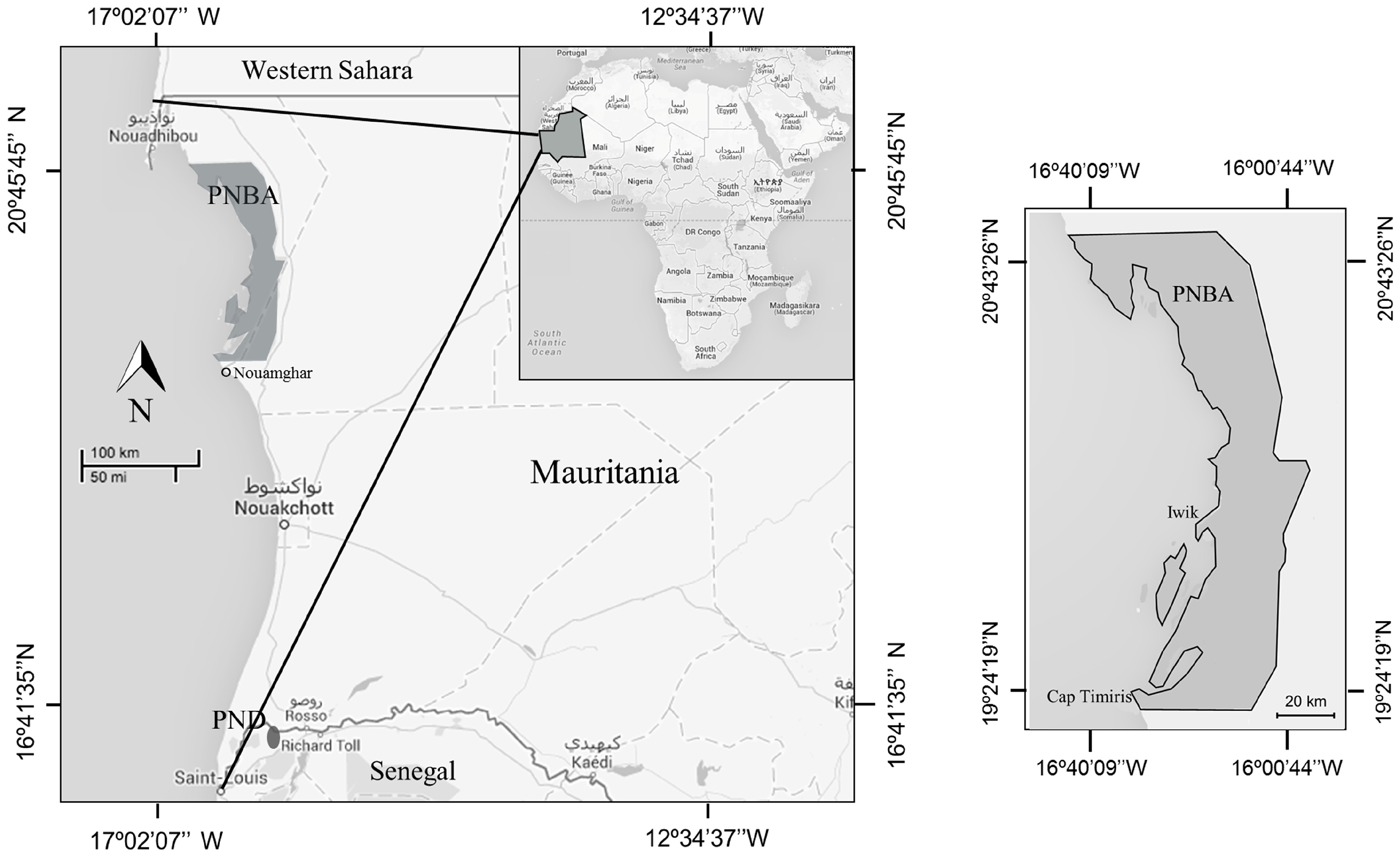
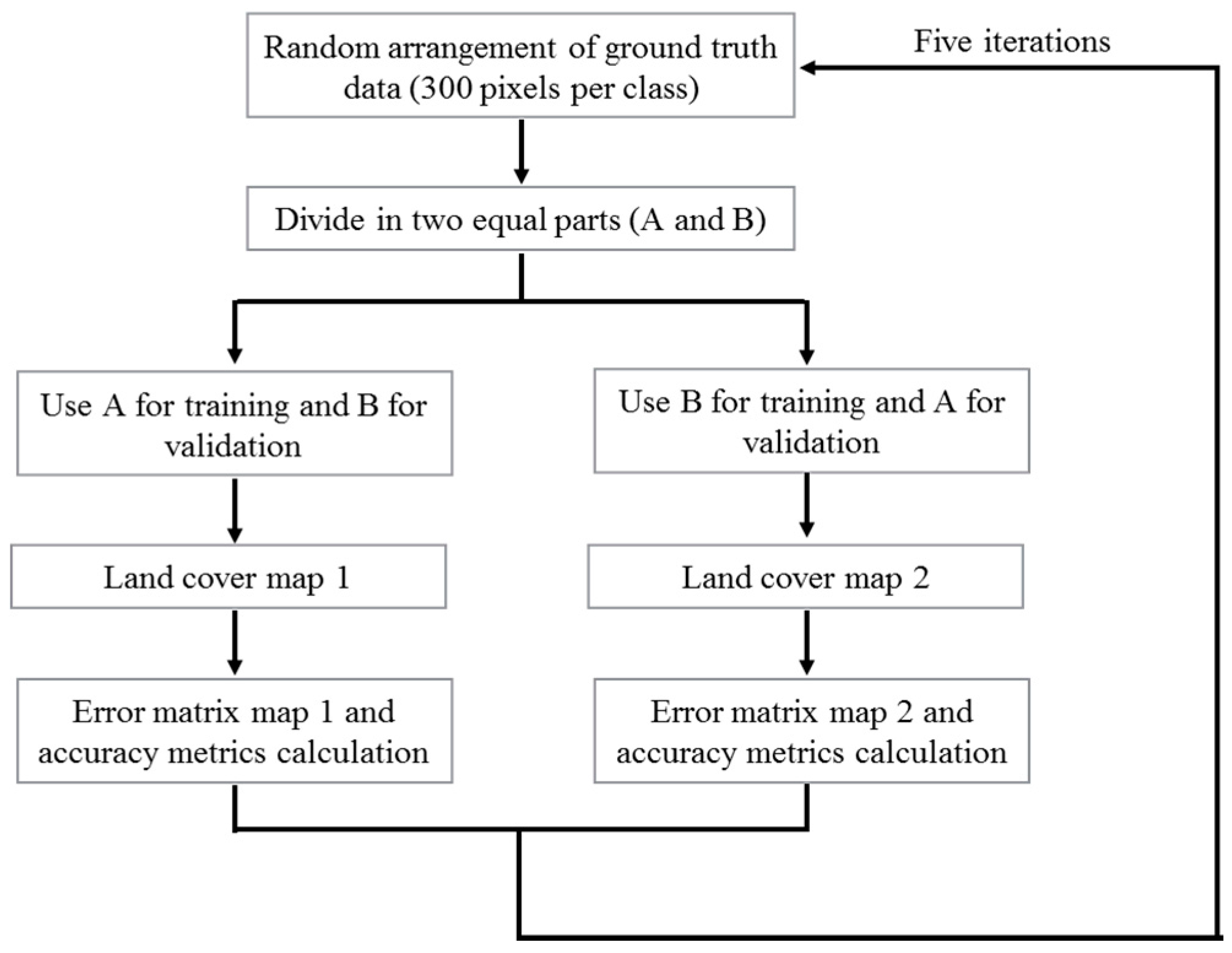
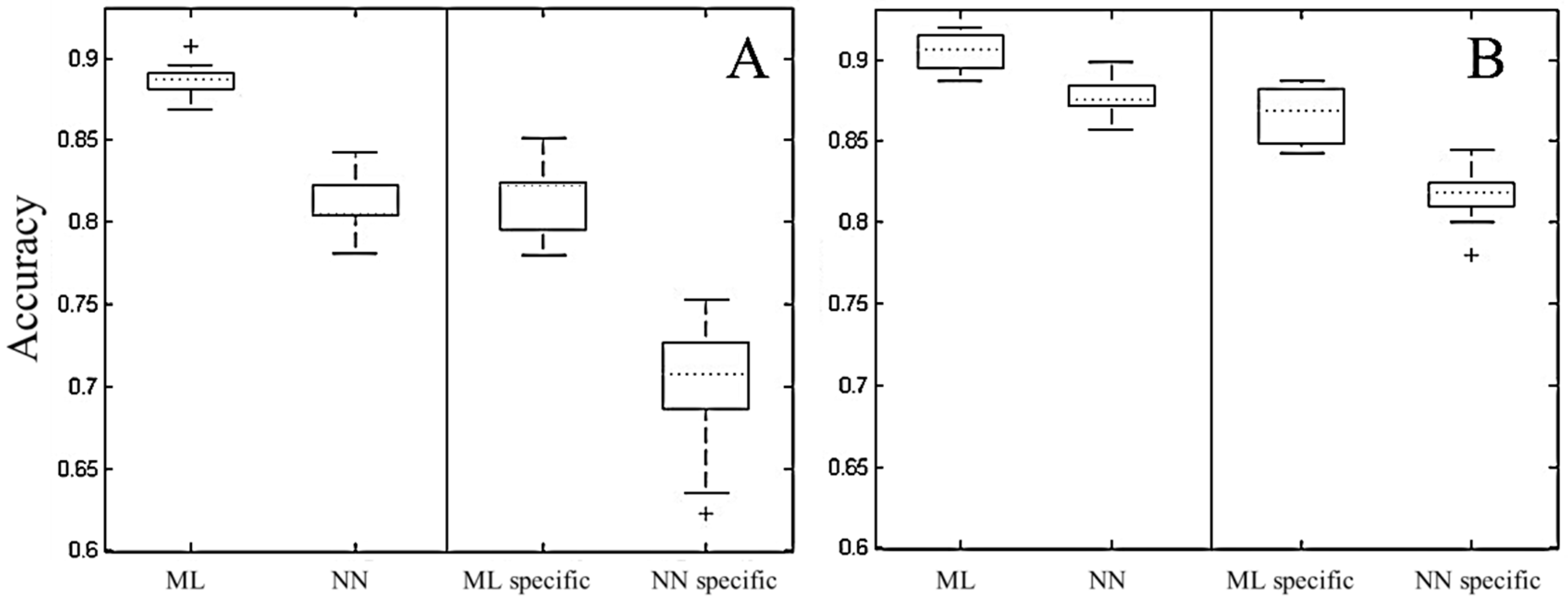
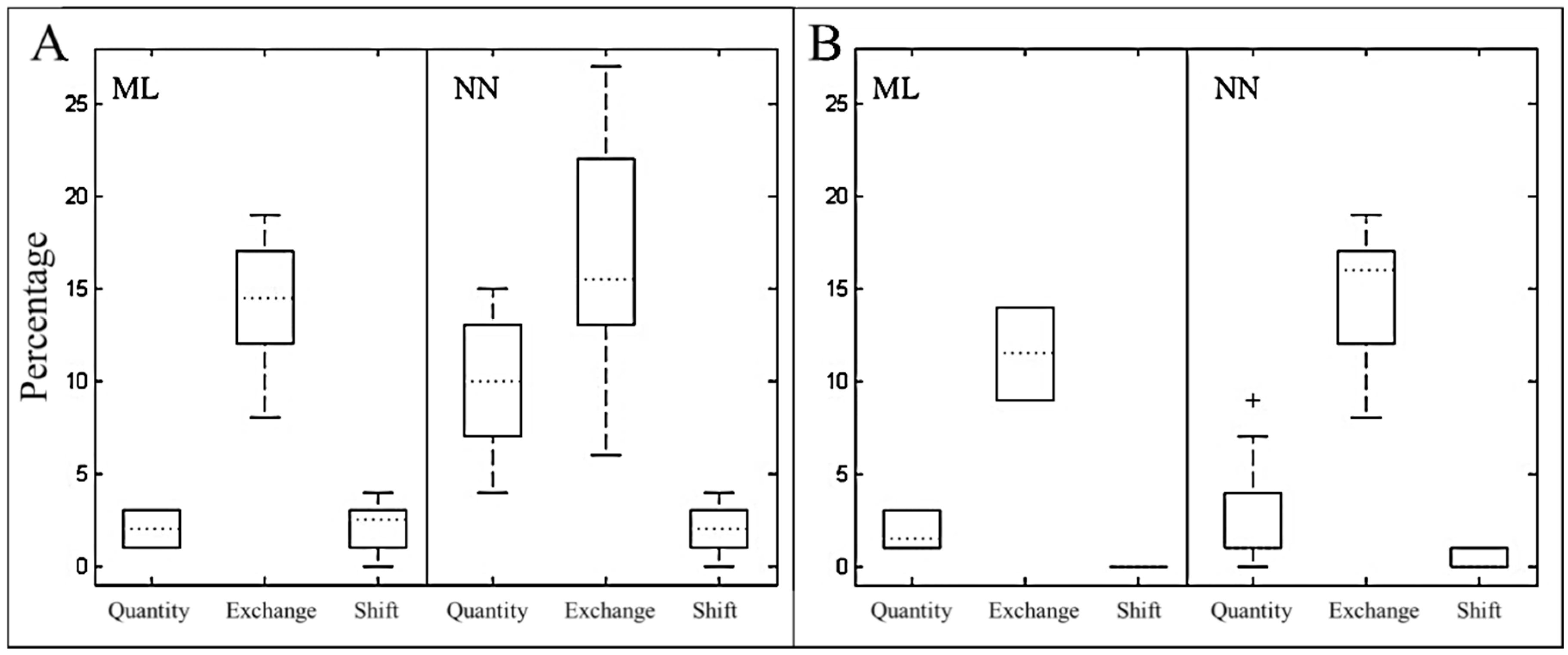
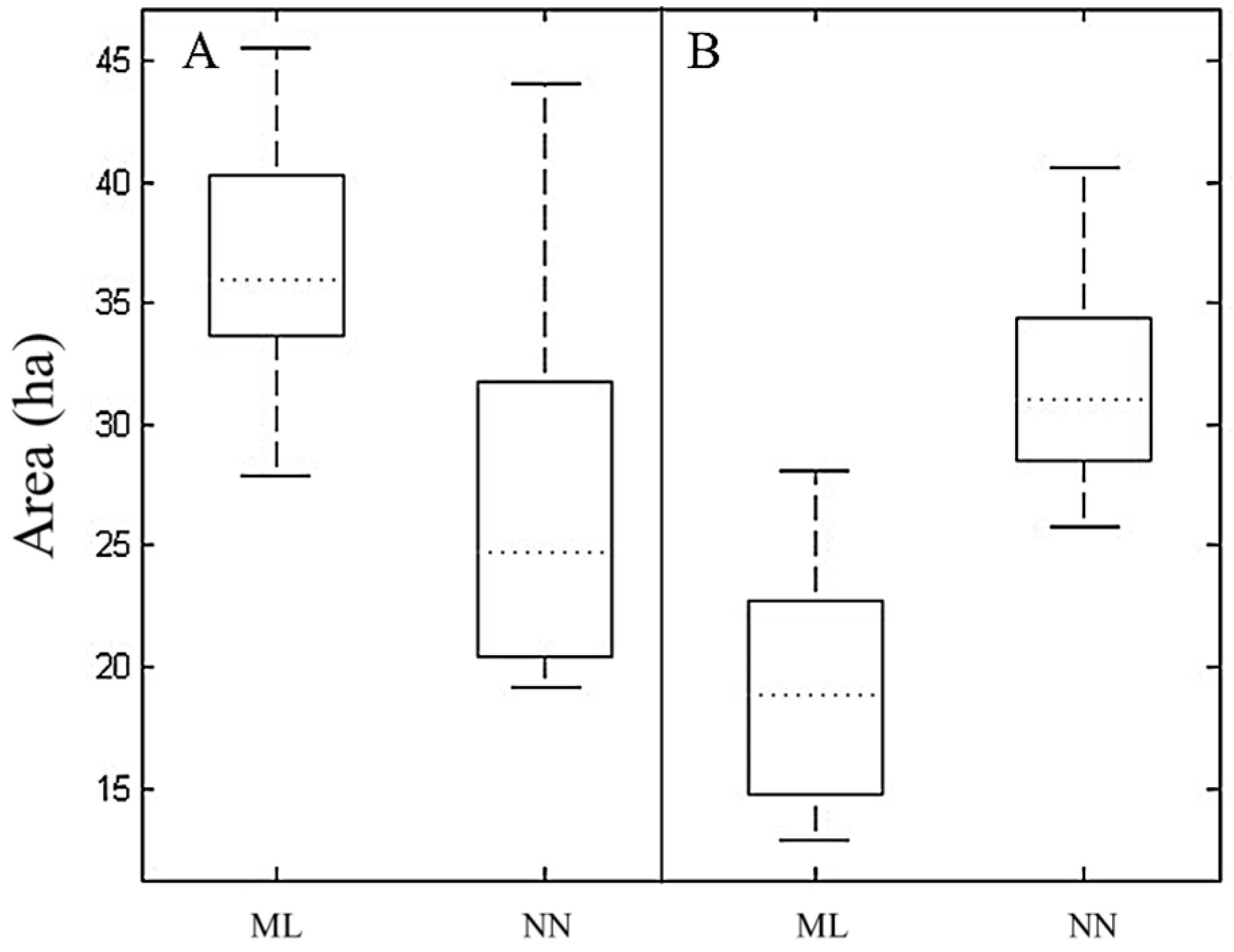
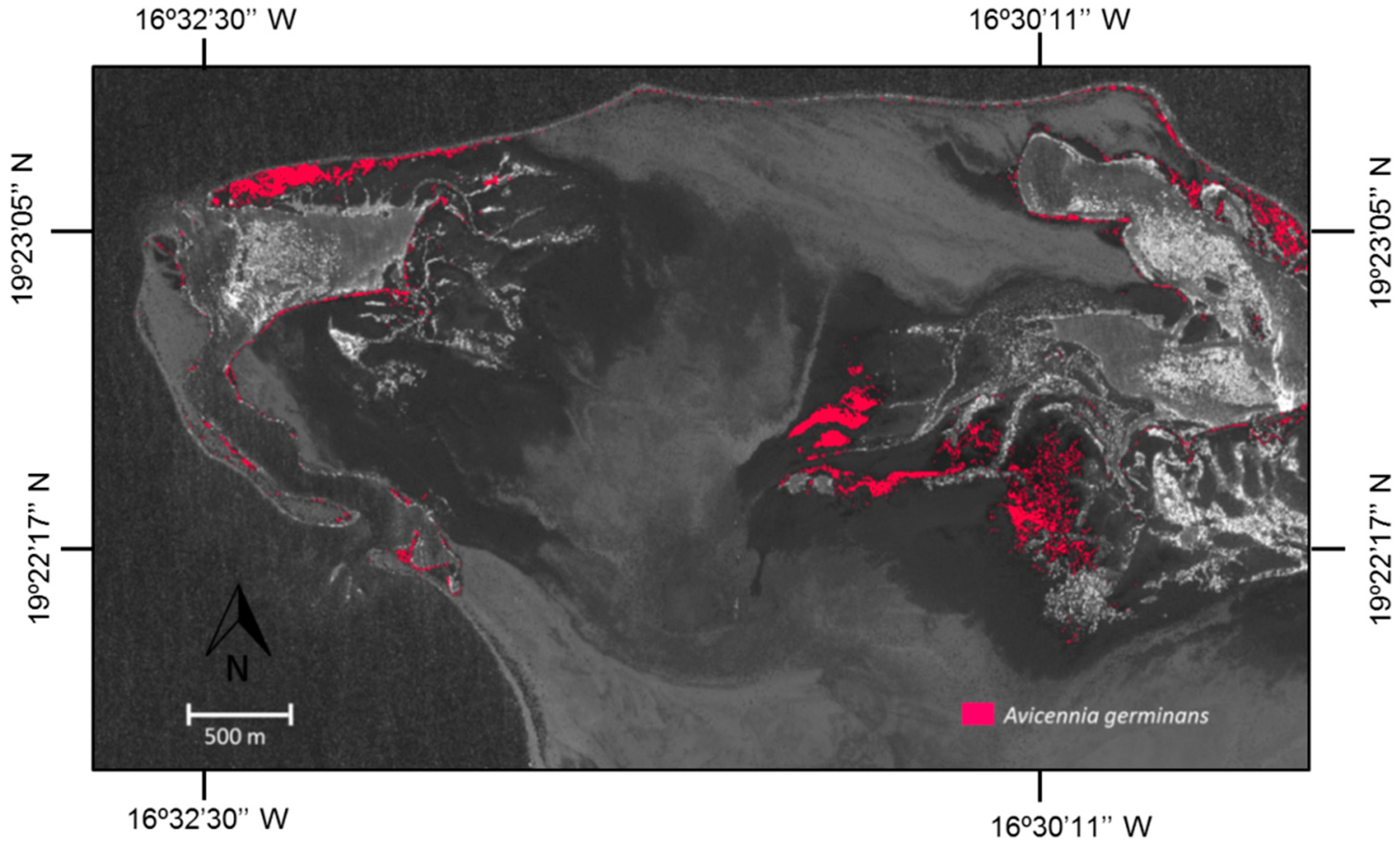
| Characteristic | QuickBird Sensor (2004) | GeoEye Sensor (2011) |
|---|---|---|
| Date and time of acquisition | 23 December 2004 at 11:46 GMT | 21 July 2011 at 11:51 GMT |
| Spatial resolution | PAN: 0.6 m | PAN: 0.5 m |
| XS: 2.4 m | XS: 2 m | |
| Spectral resolution | B: 430–545 nm | B: 450–510 nm |
| G: 466–620 nm | G: 510–580 nm | |
| R: 590–710 nm | R: 655–690 nm | |
| NIR: 715–918 nm | NIR: 780–920 nm | |
| Radiometric resolution | 11 bits per pixel | 11 bits per pixel |
| Temporal resolution | Less than 3 days | Less than 3 days |
| Algorithm | Type of Error | 2004 | 2011 |
|---|---|---|---|
| Maximum Likelihood | Omission error | 22% ± 5% | 18% ± 6% |
| Commission error | 28% ± 3% | 20% ± 1% | |
| Neural Network | Omission error | 20% ± 8% | 25% ± 9% |
| Commission error | 38% ± 3% | 26% ± 4% |
| Study | Mangrove Area |
|---|---|
| UNEP (2007) [15] | 100 ha in 2000 and 209 ha in 2006 (total area in Mauritania) |
| Lamarche (2008) [14] | 400 ha at Cap Timiris and Tidra Island in 2007 |
| Spalding et al. (2010) [7] | 139 ha (total area in Mauritania) |
| Fatoyinbo and Simard (2013) [16] | 40 ha between 1999 and 2000 (total area in Mauritania) |
| This study | 19.48 ± 5.54 ha in Cap Timiris in 2011 |
© 2016 by the authors; licensee MDPI, Basel, Switzerland. This article is an open access article distributed under the terms and conditions of the Creative Commons Attribution (CC-BY) license (http://creativecommons.org/licenses/by/4.0/).
Share and Cite
Otero, V.; Quisthoudt, K.; Koedam, N.; Dahdouh-Guebas, F. Mangroves at Their Limits: Detection and Area Estimation of Mangroves along the Sahara Desert Coast. Remote Sens. 2016, 8, 512. https://doi.org/10.3390/rs8060512
Otero V, Quisthoudt K, Koedam N, Dahdouh-Guebas F. Mangroves at Their Limits: Detection and Area Estimation of Mangroves along the Sahara Desert Coast. Remote Sensing. 2016; 8(6):512. https://doi.org/10.3390/rs8060512
Chicago/Turabian StyleOtero, Viviana, Katrien Quisthoudt, Nico Koedam, and Farid Dahdouh-Guebas. 2016. "Mangroves at Their Limits: Detection and Area Estimation of Mangroves along the Sahara Desert Coast" Remote Sensing 8, no. 6: 512. https://doi.org/10.3390/rs8060512
APA StyleOtero, V., Quisthoudt, K., Koedam, N., & Dahdouh-Guebas, F. (2016). Mangroves at Their Limits: Detection and Area Estimation of Mangroves along the Sahara Desert Coast. Remote Sensing, 8(6), 512. https://doi.org/10.3390/rs8060512






